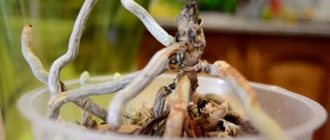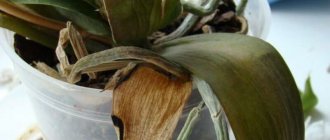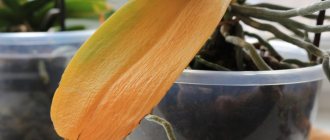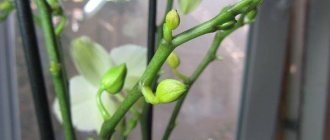An orchid is an incredibly beautiful, but whimsical and capricious flower to care for. The natural habitat of this unusual representative of the fauna is a tropical climate. It is quite difficult to reproduce such conditions at home. The lack of a favorable microclimate becomes the main reason that even an adult and blooming orchid begins to wither and then, if no measures are taken, dies. Therefore, the condition of the orchid must be constantly monitored.
Growing an exotic beauty on a windowsill requires a lot of time and effort to simply part with your favorite specimen. It is much easier and simpler to take a number of measures to resuscitate a diseased orchid. You can even save a plant that has lost its foliage. If you do everything correctly, then very soon it will once again become the main decoration of the window sill, delighting you with its sophisticated and delicate beauty. The main thing is to take all necessary recovery measures in a timely manner.
Natural aging of orchid foliage
Not all foliage problems are caused by improper care. We must not forget about the natural physiological and inevitable aging of foliage. It is characterized by yellowing of the plate. To be sure that aging is the reason for the loss of foliage, it is necessary to take into account what species the orchid belongs to. The leaves of the exotic beauty usually die off in the third month of their existence. Early falling off is typical only for dendrobium. It occurs during a period of rest. Monopodial species, among which phenopolis is the most common and grown on window sills, as a rule, do not lose all their foliage. It is considered normal for them to die off of only two leaves, which are lower than the others. Any other drop is not natural, but serves as a signal of concern about the health of the orchid.
Yellowness, accompanied by lethargy and flabbiness, is not physiological aging, but most likely overheating. To prevent the orchid from losing its leaves, it is removed from the windowsill, and after three to four hours it is sprayed and watered with settled water. On the fourth or fifth day the plant will come to its senses, but it needs to be placed in a new place.
Orchid growth point - what is it?
This is the vegetative part of orchids. With its help, new leaves, side shoots, and flower buds develop.
Its location varies depending on the structure of the root system:
- In monopodial plants it is located in the recess between the apical leaves. It remains in this form until the beginning of the growing season. Then it turns into light green shoots at the top of the flower.
Monopodial species: Phalaenopsis, Vanda.
- Sympodial orchids have several growth points. They appear and die throughout the life of the plant. These points represent shoots on which pseudobulbs grow. After flowering, the formed shoots stop growing, and the point dies.
Sympodial species: Cattleya, Dendrobium, Oncidium.
The monopodial type includes plants with one main vertical shoot. Sympodial plants develop from a horizontal shoot - a rhizome, which annually produces new shoots. They form their own pseudobulbs, leaves, peduncles and flower buds or vegetative shoots.
For what reasons does an orchid lose its leaves?
Loss of foliage in orchids is most often associated with improper care. There are a huge number of points, each of which must be followed. Otherwise, an exotic and capricious flower may be left without leaves. The bareness of the stem in orchids is usually directly related to the condition of the root system. Often, novice gardeners overwater the plant. This is due to the erroneous assumption that orchids love moisture. In its natural habitat, this exotic representative of the flora actually grows along the coastline of reservoirs, in tropical forests, on sea slopes or in gorges. Its roots are never completely immersed in water. If you water an orchid too much at home, the root system will simply begin to rot. Therefore, moisture stagnation in the soil should not be allowed. When a plant has not been watered for some reason for a long time, the best way to prevent excessive flooding is to dip the roots in water for 10 minutes and then spray the foliage.
Treating orchids for rot
Plants affected by fungal diseases and rot are the most dangerous. Fungal spores quickly spread through tissues and can also infect other plants. To get rid of the disease, you need:
- Using a sharp knife, remove all rotten parts of the orchid to the healthy green pulp.
- Treat sections and exposed tissue with a disinfectant. It can be replaced by cinnamon powder, activated carbon, a solution of brilliant green or iodine.
- Allow all treated areas to dry.
- Treat the soil and the plant itself with a fungicide.
For this purpose, Fitosporin-M is used at the rate of 100 ml per 1 liter of water. In case of severe damage, take 200 ml of water per 100 ml of product. The drug is diluted in purified water at room temperature.
Another fungicide effective against rot is a low concentration solution of copper sulfate. For 500 ml of water, take several crystals - on the tip of a knife. Antiseptic is used for adult orchids. Treatment of young flowers is carried out with Bordeaux mixture, which is diluted at the rate of 4 ml of product per 10 liters of water.
Repeat the disinfection procedure two or three times within 2 weeks.
If the decay can be stopped, optimal growing conditions are created for the orchid.
Reanimation of an orchid without leaves
There are several ways to save an exotic tropical plant from death. Which method to resort to depends on the condition of the orchid itself and the availability of free time. The latter is the most important point. If you violate any point of the rehabilitation process, all efforts will be reduced to a minimum. Since the most common cause of foliage loss is flooding of the root system, so that rotting does not spread to the foliage, the orchid must be removed from the pot. Shake off the soil from the rhizome and dip it in a basin filled with warm water for exactly ten minutes. Not a minute more, not a minute less.
Incorrect temperature
Very often, domestic flower growers, when buying such a flower, do not really think about how to create favorable conditions for it. Standard watering, lighting and adding nutrient mixtures to the substrate are not what the orchid likes. In this case, other care recommendations must be followed. And your key task is to know about them.
However, even with the highest quality care for your indoor orchid, something can still go wrong. Why doesn't the orchid grow leaves? If the flower stops appearing new leaves, first of all pay attention to the temperature conditions maintained in the room. Ideally, it is necessary to grow an orchid in conditions from +21 to +26 °C. Such temperature indicators are considered optimal for the full development of an orchid.
Another common reason for the lack of new leaves on your indoor flower is direct sunlight. In summer, when the temperature reaches its maximum, leaving an orchid on an open windowsill where the sun is hot is strictly prohibited. Otherwise, burns will appear on the green mass of the flower specimen, and new leaves will stop growing.
In winter, it is advisable to provide slightly modified conditions for the houseplant. The temperature should be reduced to +16…+20 °C. At the same time, think about whether it is worth leaving the flower in a flowerpot on the windowsill, where the temperature may be low.
Another important requirement: try to ensure that the temperature readings do not change too sharply. If the differences are more than 5–6 °C, such conditions can cause not only the absence of new leaves, but also the death of the flower specimen.
Be sure to maintain the optimal temperature in the room if you want the plant to feel comfortable in your home.
A simple way to save an orchid
It is recommended to resort to it only under favorable conditions for the tropical beauty. This means that it is kept at an optimal level of air humidity and good light. Both of these factors must correspond to the orchid variety. No deviations are allowed. The stalk that remains without leaves is planted directly in the moss. Watering must be correct. For each, only one tablespoon of settled water is enough. Moisture is absorbed by the moss and distributed evenly, and, therefore, the plant receives the amount of liquid it needs. This method is quite simple, but not always effective, since it is very difficult to recreate ideal conditions. They resort to it most often when the plant has simply been flooded or taken by a stem without leaves.
You can plant the rescued plant in a new container when the stem gets stronger and the root system begins to grow, which indicates that the orchid feels great in the moss. The main thing is that the container is located correctly, that is, in a place where the tropical beauty will not be in danger of overheating, hypothermia or drafts.
Mistakes in caring for orchids
- You cannot move a plant from one place to another, because the orientation of the light changes, it is difficult for the plant to get used to a different direction of the rays each time, it loses its strength, and because of this, the flower stalks stop developing. It is recommended to leave the pot with phalaenopsis in one place in one position and not turn it in different directions towards the light. The orchid does not need to be disturbed.
- The roots of an orchid are able to absorb moisture when a sufficient amount of light falls on its leaves, preferably diffused, muted rays of sunlight. If there is not enough lighting and the substrate is wet, then the roots of the orchid, which have absorbed moisture, cannot further transport it to the leaves and peduncles, so the destruction and rotting of the roots begins. So, the most important thing for orchids is light.
- Every two years you need to change the soil in the pot.
The second method of plant resuscitation
The orchid is pulled out of the water. Wait for the plant to dry completely. The root system is examined and assessed. Rotten shoots and leaves are removed with sharp scissors, pruning shears, or a blade. The instrument is pre-treated for sterilization. The cut areas are sprinkled with powder. It is prepared from ground cinnamon or charcoal. If the inanimate elements are not removed, the flowers will continue to rot. Leaving damaged areas will nullify all efforts to save the orchid.
The flower, cleared of leaves and damaged roots, is placed in a greenhouse. It can be purchased at a specialty store or made from a plastic container with transparent walls. The bottom is laid out with expanded clay and moss. The orchid is “planted” from above and covered with a lid. The main requirement for keeping an orchid in a greenhouse is the temperature regime. It should not be higher than +33 degrees. If the temperature is higher, rotting will resume. At night, the temperature should be kept between +20 and +25 degrees.
How to get your roots in order
To save the flower, resuscitation measures should be resorted to immediately. Of course, we start from the roots. So, a healthy orchid root system meets the following characteristics: the roots are dense, elastic and uniform along their entire length, have a uniform color, they are dry, smooth and hard. If, when you take the orchid out of the pot, you see a completely different picture, it means the plant is sick. The affected roots will be slippery, have a changed shade, and destroyed thread-like root processes will be noticeable.
Don't panic, let's get down to business! First of all, we get rid of all damaged roots, including dried ones. Sprinkle all the sections with crushed activated carbon, then send the plant to dry for several hours. Next, we place the remaining roots in a fungicide solution - this will prevent the development of a fungal infection. Now you can treat the roots with a growth stimulator and plant the orchid in fresh substrate.
Preventive measures to prevent orchid leaf loss
Neither the leaves nor the root system will rot if the appropriate care rules are followed. The first and most important thing comes down to the fact that the orchid calmly tolerates dry soil, but rots when water stagnates at the bottom of the container.
It is quite difficult for novice gardeners to determine when the soil needs additional moisture. A plastic pot will be an excellent helper in watering. Its transparent walls will be an excellent guide for monitoring the condition of the rhizome, so as not to dry out or flood the soil.
Orchids get sick not only due to overheating, but also due to lack of lighting. In both cases, the plant requires a change of residence. Otherwise, resuscitation of the flower will not be successful. You cannot place an orchid on a window without curtains or blinds, or next to heating devices that are not covered with a shield. This will cause overheating.
The best choice would be to place the orchid on a special stand. It should be located near a window oriented to the southeast or southwest. The main thing is that direct rays do not fall on the foliage of the flower. Otherwise, the plates will get burned, which will cause them to fall off.
Sick plant roots are a reason to take emergency measures
If the root system is dead, then the leaves will not have enough nutrition and the bush will shed them . Therefore, it is necessary to organize watering in such a way that the roots of the plant do not begin to rot.
Possible reasons
Let's look at the main reasons why an orchid may lose its leaf mass:
- Poor lighting - an orchid can tolerate a lack of diffused sunlight for a short period. But if it drags on, the plant weakens, the leaves stretch out and become thinner. As a result they fall off;
- Loss of roots - roots most often die from rotting, since inexperienced gardeners often water their orchid without allowing the substrate to dry out;
- Overheating of the plant - under the influence of elevated temperature, the leaf mass evaporates too much moisture and the turgor of the leaf mass is lost, and, as a result, the orchid bush loses its foliage;
- Fusarium is a fungal disease that causes loss of foliage. If you start treating the plant in time, it will still lose some of its foliage, but the gardener will still have a chance to save the entire remaining bush.
IMPORTANT! If you properly care for your orchid bush, it will not shed its leaf mass, but will only increase it.
Healthy root.
How to distinguish a diseased and rotten root from a healthy one?
Even a beginner in growing orchids can distinguish a healthy root from a diseased one.
A healthy root has:
- The color of the root is light green with a silvery tint of velamen;
- Elastic;
- Does not deform when pressed;
- Roots growing in the thickness of the substrate acquire a light brown tint due to the lack of sunlight.
Damaged and problematic roots:
- They have a putrid odor ;
- Dark color;
- Soft to the touch;
- When pressed, a liquid with a putrid odor is released.
Sick and rotten orchid roots.
What to do with diseased plant roots?
If damaged roots are found, they must be cut with pruning shears to a healthy place that has a light cut.
The pruning shears are treated with alcohol after each plant that is being reanimated, so that if one of them is infected, it does not infect all the flowers that are at that moment under resuscitation.
After all areas affected by rot have been cut out, the sections are treated with one of the antiseptics:
- Activated carbon;
- Wood ash;
- Cinnamon.
After pruning and antiseptic treatment, the remaining root mass must be dried for at least 8 hours, after which the flower is planted in an appropriate substrate.
IMPORTANT! The first watering is carried out on the 5th day after planting. This time is necessary for the healing of all wounds caused to the roots during resuscitation.
Let's help revive an orchid: how to save a flower without roots and leaves, or with just one thing?
Despite the fact that many types of orchids are easy to care for, in the process of growing them you can encounter a number of problems. The most common of them is rotting of the root system. This is especially true in autumn and winter. It happens that the roots and leaves of the orchid completely die off. Is it possible to save the plant in this case? It's worth finding out.
When is resuscitation no longer useful?
If you notice that the orchid in the pot does not hold well and can be easily swung in different directions, then do not waste time, but remove the flower from the pot and inspect it.
Immediately assess the condition of the roots. If there are soft, dark, slippery tissues filled with water and mucus, then they have already rotted. Living tissue of the root system is dense, hard and light brown in color. If there are no living tissues left at all, this indicates that it will no longer be possible to revive the flower.
If the orchid has not recovered within a year, then there is a high probability that this will not happen.











